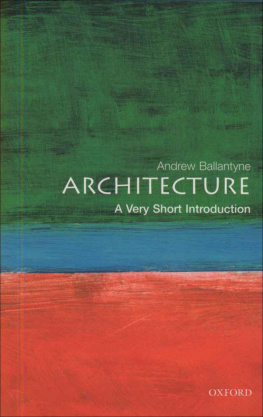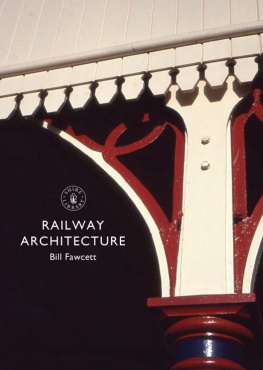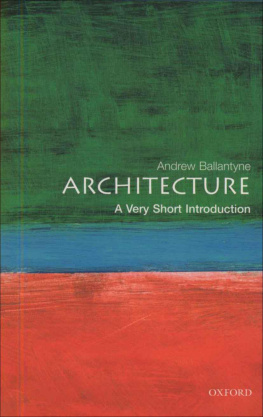Key Buildings from Prehistory to the Present
Plans, Sections and Elevations
Andrew Ballantyne

Published in 2012
by Laurence King Publishing Ltd
361373 City Road
London EC1V 1LR
Tel +44 (0)20 7841 6900
Fax +44 (0)20 7841 6910
E
www.laurenceking.com
Drawings and design copyright 2012 Laurence King Publishing Ltd
Text 2012 Andrew Ballantyne
This book was designed and produced by Laurence King Publishing Ltd, London
Andrew Ballantyne has asserted his right under the Copyright, Designs and Patents Act 1988 to be identified as the Author of this work.
All rights reserved. No part of this publication may be reproduced or transmitted in any form or by any means, electronic or mechanical, including photocopy, recording or any information storage and retrieval system, without prior permission in writing from the publisher.
A catalogue record for this book is available from the British Library
ISBN 978 185669 837 5
Project managed and edited by Henrietta Heald
Designed by The Urban Ant Ltd.
Picture research by Claire Gouldstone
Printed in China
Key Buildings from Prehistory to the Present
Plans, Sections and Elevations
Andrew Ballantyne
Laurence King Publishing
Contents
Introduction
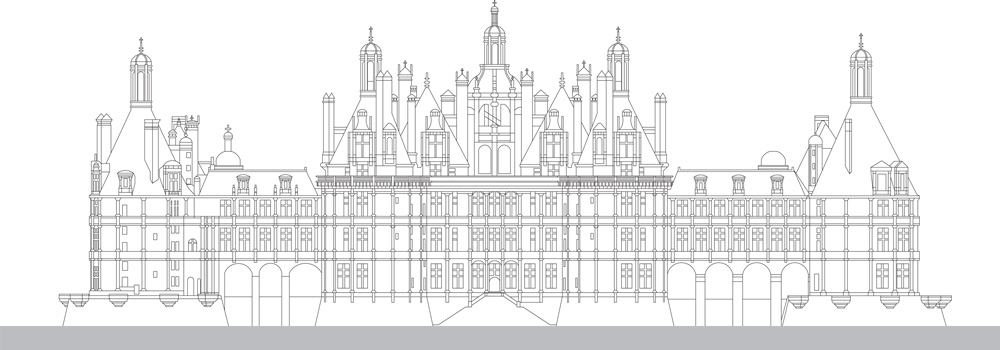

Great Temple of Amon-Ra
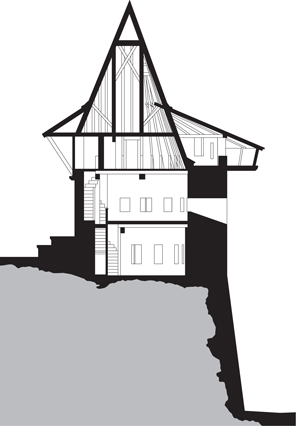
Carcassonne
Architecture does many things, and Key Buildings from Prehistory to the Present explores a range of them. Each chapter covers an aspect of architecture through a number of buildings from around the world. The buildings are illustrated in plan, section and elevation, as well as photographically, and appear in chronological order in each category.
In many cases, a building could be put in more than one category. The Great Pyramid of Khufu (pages 1415) is a memorial and the Empire State Building (pages 3839) is an office building, for example, but they are both included in chapter 1 in order to highlight how some buildings come to designate a culture. There is an international shorthand that can evoke the idea of a complex and varied country in an image of a single building. France is signified by the Eiffel Tower (pages 3637), China by the Twin Pagodas at Suzhou (pages 3031).
The choice of representative buildings poses a dilemma. While the best buildings are remarkable, ordinary buildings can tell us far more about the culture, climate and technology of the society that made them. This tension is clearest in chapter 2, whose subject is dwellings. It includes traditional houses from different parts of the world alongside some acknowledged masterpieces and royal retreats. One of the Karo Batak Houses in Sumatra (pages 5859) is different in every way from Andrea Palladios Villa Capra (pages 7071) or the castle of Neuschwanstein (pages 8485), for example, except that all three were dwellings that met the needs of their occupants.
Places of worship, covered in chapter 3, always call for special efforts from the community that builds them, and they usually have pride of place in a settlement. Sometimes as in the case of the Great Temple of Amon-Ra (pages 100101) they are associated with the state and can be colossal. Other examples, such as the Lingaraj Temple (pages 12223) and the Basilica of the Madeleine at Vzelay (pages 13031), have been sustained by popular support from pilgrims.
At the heart of chapter 4 are historical defences, but those that are still in use can be impossible to document in plan, section and elevation. (For example, Britains signals-monitoring station at Menwith Hill in Yorkshire could not be represented, despite its eerie beauty.) The Athenian Acropolis (pages 16869) had a military use in the seventeenth century, when a Venetian shell hit a store of Turkish explosives and blew up the Parthenon. It was a celebrated place, but difficult to visit. In the nineteenth century, when they were judged to be militarily redundant, the ramparts of Carcassonne (pages 18485) were transformed into a potent vision of a medieval city.
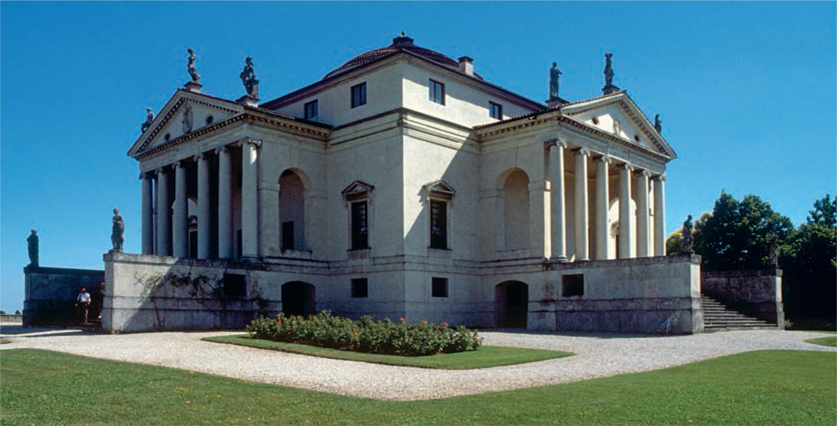
Villa Capra
Chapter 5 covers buildings where people work, study or pass through on their travels. Such edifices often have to be built economically, but even then their scale and the pride taken in their design can make them internationally significant. Titus Salts worsted mill at Saltaire (pages 208209) and the AEG Turbine Factory in Berlin (pages 22021) are buildings designed for a firmly utilitarian purpose that have nevertheless had a profound cultural influence.
Chapter 6 is concerned with government buildings ranging from the grandiose Residenz at Wrzburg (pages 25253) to Alvar Aaltos little Synatslo Town Hall in Finland (pages 26061), while chapter 7 is devoted to buildings designed to enhance the quality of peoples lives. The Theatre at Epidauros (pages 26667), a sanctuary and health resort, transformed the slope of a hillside into a powerful geometric form that, even now, commands the surrounding landscape.
The memorials described in chapter 8 are reminders of great lives and great deeds. No one now remembers much about the Persian satrap Mausolus, but the Tomb of Mausolus (pages 28889) proved the model for the many mausoleums that followed. The Lincoln Memorial (pages 300301) is not one, since it is not a burial place, but it serves to commemorate a life and to remind a mighty nation of its values.
The public spaces in chapter 9 are reminders of how cities work, illustrating the fact that urban vigour and vitality depend on chance or casual meetings in the street and in public, as well as on formal meetings in more private places.
In short, this book presents a wide range of structural achievements. It is incomplete, of course, but all the examples chosen are interesting and intended to open your eyes to other things that are equally interesting and may be closer to home.

Theatre at Epidauros
Culture-defining monuments

Many cultures produce no monuments. The Mongols were one of the great dynamic civilizations and their culture revolved around horsemanship rather than building. Architectural history hardly notices people such as the Mongols, giving pride of place to sedentary cultures that walled themselves in with blocks of stone Egyptians, Romans, Chinese.
Uluru is a striking landscape formation that was adopted by the nomadic Aboriginal population in Australia and made to do all the things that monuments do, so it is included in this chapter as landscape architecture that has a monumental role for a culture that grew up around it.
Next page



